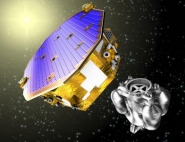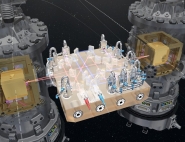Ground Segment
The LISA Pathfinder ground segment has two operational centres, both provided by ESA:
- The Mission Operations Centre (MOC) at the European Space Operations Centre (ESOC) in Darmstadt, Germany, is responsible for the Launch and Early Operations Phase (LEOP), the transfer phase and all operations during the routine phase. The MOC is in contact with the spacecraft for eight hours per day through the ground station(s).
- The Science and Technology Operations Centre (STOC), located at the European Space Astronomy Centre near Madrid, Spain, is the interface to the scientific community and is responsible for payload scheduling, quick-look data analysis, data processing and archiving.
Communications with the spacecraft are performed in X-band through a network of ground stations, including Kourou, Maspalomas and Perth, during LEOP. For this the ground station infrastructure has been upgraded with X-Band acquisition aids mounted on the LEOP stations.
During science operations, communications are performed using DSA-2, the 35-metre X-band deep-space antenna located at Cebreros in Spain. Using this station, a communications link is established for six to eight hours per day. During each pass, the data stored on board are retrieved, spacecraft tracking is performed and the command timeline is uplinked.
Following the initial in-orbit check-out and instrument calibration, the STOC is responsible for the inflight demonstration of the LISA technology. The STOC major task is to plan and validate the use and related configuration of the scientific instruments on board the spacecraft, derive from the mission products the science and technology results, and feed these results back into later planned instrument activities.
French scientists are involved in STOC operations. In addition, the FACe (François Arago Centre) functions as the French data and analysis centre, complementing the ESA dedicated locations. The FACe is located at the APC laboratory (Laboratoire AstroParticule et Cosmologie) on the Space Campus of Paris Denis-Diderot University. It provides the environment for data exploitation during the mission, meeting facilities, access to data and analysis tools for scientists involved in the mission.
LISA Pathfinder's science operations will last six months; split between 90 days for the LISA Technology Package (LTP) and 90 days for the Disturbance Reduction System (DRS). The DRS experiment will be using the European LTP sensor for its measurements.
All of the data accumulated by the LTP, and a subset of the data analysis products, will be archived by the STOC and made available to the wider scientific community. The LTP team has proprietary data rights for the first three months, after which time the archive will be in the public domain.

